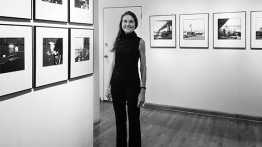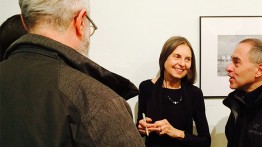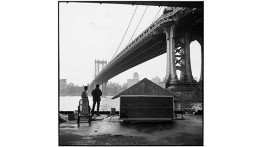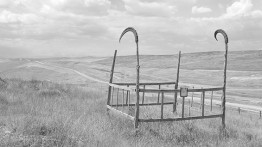In Memoriam: Margaret Morton
POSTED ON: July 1, 2020
Margaret Morton, former School of Art Professor, passed away unexpectedly in New York City on June 27, 2020. Morton taught, mentored, and motivated generations of Cooper students who passed through the school. For many, their Cooper education began with Professor Morton in the first-year Foundation 2-Dimensional Design course. In addition to graphic design and photography, she was known for teaching Art of the Book, an annual course exploring the medium of the “artists book." She had a profound influence on four decades of designers and photographers.
Morton was a gifted photographer who chronicled the lives and ingenuity of homeless people. In 1989, Morton began documenting the improvised housing created by people living in Manhattan’s Tompkins Square Park. In the decades that followed, she built a remarkable record of how people live and survive at the edge of a society that overlooks them. Her photographs have appeared in numerous publications, including The New York Times, The Washington Post, and The Atlantic, and her works have been shown in dozens of solo and group exhibitions. Her books include The Tunnel: The Underground Homeless of New York City (Yale University Press, 1995), Fragile Dwelling (Aperture, 2000), Transitory Gardens, Uprooted Lives (Yale University Press, 1993), and Glass House (Penn State University Press, 2004).
Phillip Lopate has written, “Margaret Morton has been doing remarkable, indeed invaluable, work at the juncture of photography and social documentation. She is our modern-day Jacob Riis.” Every image and oral history she produced serves to honor an individual she encountered in the city’s parks, vacant lots, abandoned buildings, and underground tunnels. Her last book of photographs, Cities of the Dead, the Ancestral Cemeteries of Kyrgyzstan, was published by University of Washington Press, 2014. The photographs were presented in a 2015 exhibition in the Arthur A. Houghton, Jr. Gallery.
Morton received her MFA from the Yale University School of Art. She began teaching at The Cooper Union School of Art in 1980 and became full-time faculty in 1985.
—Ellen Lupton A’85
Read the New York Times obituary: Margaret Morton, Photographer at Home With the Homeless, Dies at 71
Following are just a few remembrances from alumni and colleagues. Additional memories can be shared at a Facebook group in her memory. In lieu of flowers, donations to The Cooper Union Annual Fund in memory of Margaret Morton can be made online at cooper.edu/give or mailed to The Cooper Union, Office of Alumni Affairs and Development, P.O. Box 22422, New York, NY 10087-2422.
“Margaret was the kindest, most sincere, yet most fearless person. She was always patient with students and incredibly generous with her time. She opened the door to me to teach at Cooper after I graduated, asking me to return to teach 2DD, and she continued to support me as a faculty member and dean. Her commitment to the School of Art as both faculty and through her work overseeing our foreign exchange program was unparalleled. She was deeply committed and cared so much about Cooper, giving much of her time to ensure students would flourish. When she retired, she returned a piece of work that I made years earlier in my first class with her. She had used it as a class example for students who came after me. It was pristine and in perfect condition as if I had just handed in the assignment. And that was her – taking care and honoring us. I will miss her and her smile so much.”
—Mike Essl A’96, Dean, School of Art
"Margaret was a fearless photographer and my foundation teacher at The Cooper Union; she taught me how to strengthen a sensitive/discerning eye towards sequencing. She helped me see power in the little seemly inconsequential choices artists make and taught me to practice patience and listen with my eyes."
—Leslie Hewitt A'00, Associate Professor, School of Art
"Hearing everyone's stories about Margaret, you really see what a supportive force she was for so many years, for so many young students and artists. She poured herself into teaching and mentoring young people. She was the first in Cooper Union to recognize my interest in Motion Graphics (even before I fully realized myself!) and she was also the person who first asked me (then later had to convince me) to try teaching. When she realized I had started to work on videos and commercials, her first question was: 'Who taught you to do that?' Her next question was: 'Do you know anyone who could teach students to do that?' When I replied that I didn't really know anyone, her response of course was 'Why don't YOU teach it?' A month later, she had weekend workshops set up for me to teach. That was 20 years ago, and I have continued to teach at Cooper Union to this day. She really made sure that students understood what came along with their admission into Cooper Union. That you were expected to give back. Expected to help other people develop too. It wasn't a race. It wasn't a competition. It was a community. And she really lived that. I believe Cooper Union will miss her terribly."
—John Vondracek A’98, Adjunct Professor, School of Art
"Margaret opened our eyes to the beauty that we didn’t know existed in ourselves and in everyone she knew. She respected, appreciated, validated, and documented humanity, and life with intelligence, irony and compassion where others just saw ugliness. Margaret was the gentlest, most unassuming, talented, brilliant artist, photographer, devoted teacher, author. I am grateful to call her my dear friend."
—Janet Odgis, former Adjunct Professor, School of Art
"I was Margaret's photography student and worked with her in her apartment to transcribe hours of recorded tape for one of her books. Even now, I can hear her voice, feel her care for those whose lives she honored, loved, and documented so that their lives would be remembered. Margaret is one of those unforgettable individuals whose artistry and work made a life-long impact on me. You have left a legacy in us."
—Yvette Rock A’97
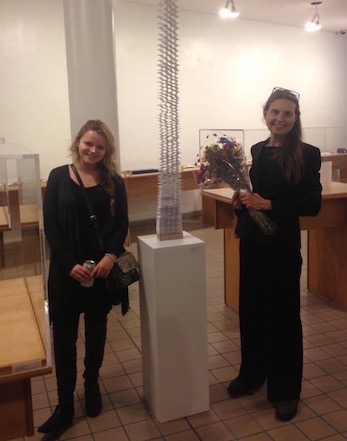
“Margaret single handedly changed my life. I had her as a professor my very first semester of college and took classes with her every semester until graduation. She inspired me to want to become an art educator and one day professor. She was the greatest mentor and friend. Every step of my professional career Margaret was there. Her wisdom and talents will live on forever.”
—Morgan Roslyn A’17
"I feel so fortunate to have had Margaret as a professor, mentor, and later friend. I remember the first time I saw her work during my Foundation year. I was struck by its raw beauty and the incredible narrative of human existence it relayed. I am so grateful for the ways in which she encouraged me to use my photography not just as an image, but as an object that can promote some social change. This guidance was essential fuel for me in a series of community projects I did in India while still studying at and after completing my time at Cooper. In addition to her phenomenal and courageous work as an artist and professor - and what brings tears to my eyes now - is that Margaret had such an immensely kind and generous heart."
—Sophie Herbert Slater A'07
“Margaret Morton was becoming a regular at our Thanksgiving dinners and other family celebrations. In between, we’d meet for lunch at the B-Bar. She was looking forward to the many new projects that awaited after retirement, but we both agreed that professors never actually ‘retire.’ Margaret’s pathbreaking work was mostly in photo-ethnography. Her books, Fragile Dwelling, Glass House, and The Tunnel, documented the lives, relationships, and material conditions of the homeless. She became their friend and advocate and through her work gave them the voice they needed. In a sense she became their ambassador.”
—Anne Griffin, Acting Dean, Faculty of Humanities and Social Sciences

